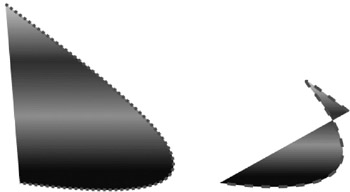Rendering Cubic Bezier Curves
|
|
|
Linear Gradient Shading and Cubic Bezier Curves
Consider the cubic Bezier curves rendered in Figure 5.5.

Figure 5.5: Linear gradient shading and cubic Bezier curves.
The SVG document in Listing 5.5 demonstrates how to use the SVG path element in order to combine linear gradient shading with a pair of cubic Bezier curves.
Listing 5.5 cBezier2LG4Pipe1.svg
<?xml version="1.0" encoding="iso-8859-1"?> <!DOCTYPE svg PUBLIC "-//W3C//DTD SVG 20001102//EN" "http://www.w3.org/TR/2000/CR-SVG-20001102/DTD/svg- 20001102.dtd"> <svg width="100%" height="100%"> <defs> <linearGradient gradientTransform="rotate(90)"> <stop offset="0%" stop-color="#C0C040"/> <stop offset="30%" stop-color="#303000"/> <stop offset="60%" stop-color="#FF0F0F"/> <stop offset="90%" stop-color="#101000"/> </linearGradient> </defs> <g transform="translate(20,20)"> <path d="M0,0 C200,150 400,300 20,250" stroke-dasharray="4 4 4 4" fill="url(#gradientDefinition1)" style="stroke:blue;stroke-width:4;"/> </g> <g transform="translate(20,200)"> <path d="M200,150 C0,0 400,300 20,250" stroke-dasharray="12 12 12 12" fill="url(#gradientDefinition1)" style="stroke:blue;stroke-width:4;"/> </g> </svg>
Remarks
The SVG code in Listing 5.5 contains the two cubic Bezier curves given below:
d="M0,0 C200,150 400,300 20,250" d="M200,150 C0,0 400,300 20,250"
By now you understand the purpose of each component of a cubic Bezier curve. The visual effect in this example is achieved by setting the fill attribute to the value gradientDefinition1, which is a linear gradient that is defined in the SVG defs element. Notice how different values for the stroke-dasharray can affect the appearance of an SVG element: the first Bezier curve has a dimpled effect whereas the second Bezier curve has a more 'standard' dotted border. You can create a Venetian shading effect by means of the following specification in the SVG defs element:
<defs> <linearGradient x1="10" y1="10" x2="100" y2="10" gradientUnits="userSpaceOnUse" spreadMethod="repeat"> <stop offset="20%" style="stop-color:#FF0000"/> <stop offset="80%" style="stop-color:#000000"/> </linearGradient> </defs>
Notice that the spreadMethod attribute has the value repeat; this results in a repetition of the linear gradient, which in turn creates a Venetian shading effect. Try removing this attribute and see how the modified code creates a much different effect. In Chapter 14 you'll learn techniques that will enable you to create much more sophisticated patterns.
|
|
|
EAN: 2147483647
Pages: 362